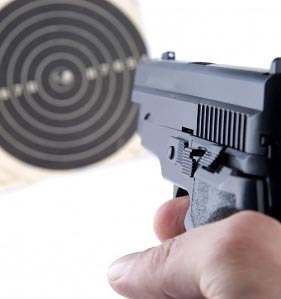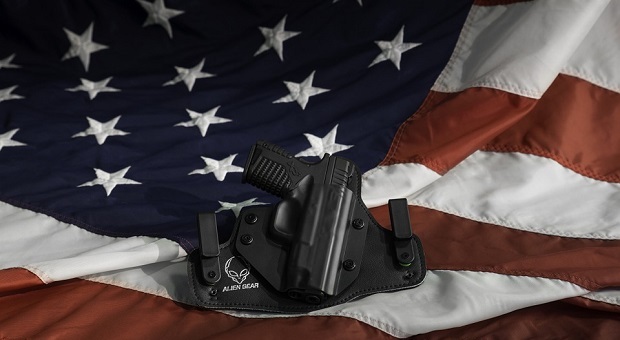Congratulations! You just bought your first firearm.
No matter whether it is the latest and greatest in gun fashion, or a used weapon, you will need to learn how to shoot safely and effectively whether for hunting and/or self-defense. Your best teachers will be commitment to a lifetime of training, practice, and gaining personal experience.
Training to shoot safely and effectively requires practice. Here are some essential tips to follow to make rookie’s training and gun usage accident-free, responsible, and enjoyable:
1. Choose The Right Gun for You
A 5‘2“ 98 pound person would have a ridiculously difficult time shooting a 500 Smith & Wesson Magnum. In fact, the recoil might hurt the shooter more than a living target, assuming they can control the gun enough to hit the target. Your handgun or rifle needs to fit you.
An experienced firearm instructor can guide you, but until you actually practice with your weapon, you may not know which model best fits your needs and capabilities. Picking a gun is like buying a new pair of shoes; you need to try it out first.
2. Always Treat Guns as if They are Loaded
If you know, or think you know you removed all the ammunition, still handle the gun as if it is loaded. Even years down the road when you are a seasoned shooter, this can prevent a tragic accident.
To see if the firearm is unloaded:
- point it in a safe direction
- remove the magazine (if it is a semi-automatic or bolt action), open the cylinder (on a revolver)
- rack the action (on a semi-automatic rifle or pistol). On a revolver, push the ejection rod.
- Examine chamber thoroughly to make sure there are no bullets in the gun (do NOT look down the barrel!)
- If there are bullets in the gun, remove them unless you are going to shoot the gun.
Never assume that someone else’s firearm is unloaded. If you are handling their weapon, follow the procedure above for checking to make sure the gun is empty.
3. Control Your Trigger Finger
Do not put your finger inside of the trigger guard or on the trigger until you are absolutely ready to take the shot. Only reach inside the trigger guard when the target is absolutely identified and you know for a certain you are going to pull the trigger.
Know exactly what your target is and where it is at all times. Know your backstop area. If it’s near anything that could get hit if you miss your shot, do not take the shot.
4. Safe Gun and Ammo Storage
Depending on your state’s gun laws, you may need an approved trigger or safety-lock. A safe, lock-box, or both may be recommended and mandatory in normal times.
5. Gun Safety and Children
Never underestimate what can happen or how strong a child’s fingers are. As for their brains, try not to let their imagination and curiosity lead children into trouble.
A child must be taught in an age appropriate manner that a gun is real and can kill. They must know only to pull the trigger if their life is in danger, or food is needed on the table.
Be open and honest about guns and gun safety. If your children are old enough, show them your guns and make it a point to model safe gun behavior. The less scary and taboo you make guns, the less they need they will feel to experiment or “show-off”.
6. Get Proper Training

There are many firearm training schools. If the goal is to learn how to shoot for self-defense purposes, then enrolling in a program is highly recommended, if not mandatory. An experienced instructor can teach you about your gun, how best to use it, and can provide you with other guns to practice with.
Shooting at an indoor range is great practice and you should go as often as possible.
7. Maintain Your Gun
Knowing the workings of your gun, and being able to clean your gun can only increase your shooting ability. Always know and be able to work your gun’s action with ease.
Checking the barrel of your weapon (when it is unloaded with the bolt/slide/cylinder open!) for any kind obstruction before you shoot can be a life saver. Keeping the gun clean and inspecting for wear/damage will help keep the weapon from backfiring and keep you out of harm’s way.
8. Protect Your Eyes and Ears when Training
When hunting or practicing, always wear safety glasses. These glasses will protect your eyes from dust, dirt and other small items when the weapon is fired. In addition, when practicing, wear ear plugs to protect your valuable hearing from noise damage.
Lack of knowledge and experience will be your biggest stumbling blocks when it comes to safe and proper shooting. Training is available through websites, books, magazines, and instructors.
The best and most valuable training will always be a one-on-one guided practice from an expert. Most important to keep in mind, whether you are a novice or an experienced firearm user, the most basic safety premises will always hold true and must always be practiced.
Keep in mind those 8 steps because gun ownership and shooting is no place for arrogance. It is a place for only knowledge, experience, and confidence.
 This article has been written by Cody Griffin for Survivopedia.
This article has been written by Cody Griffin for Survivopedia.
Photo source: 123RF.









Pingback:The Rookie’s Guideline to Gun Ownership | TheSurvivalPlaceBlog | March 29, 2014
|
Pingback:The 12 Rules Of Choosing Your Concealed Pistol | Survival skills, survival guns, survival guide | March 13, 2015
|
Pingback:The 12 Rules Of Choosing Your Concealed Pistol | The Prepper Dome | March 13, 2015
|
Pingback:The 12 Rules Of Choosing Your Concealed Pistol | TheSurvivalPlaceBlog | March 16, 2015
|